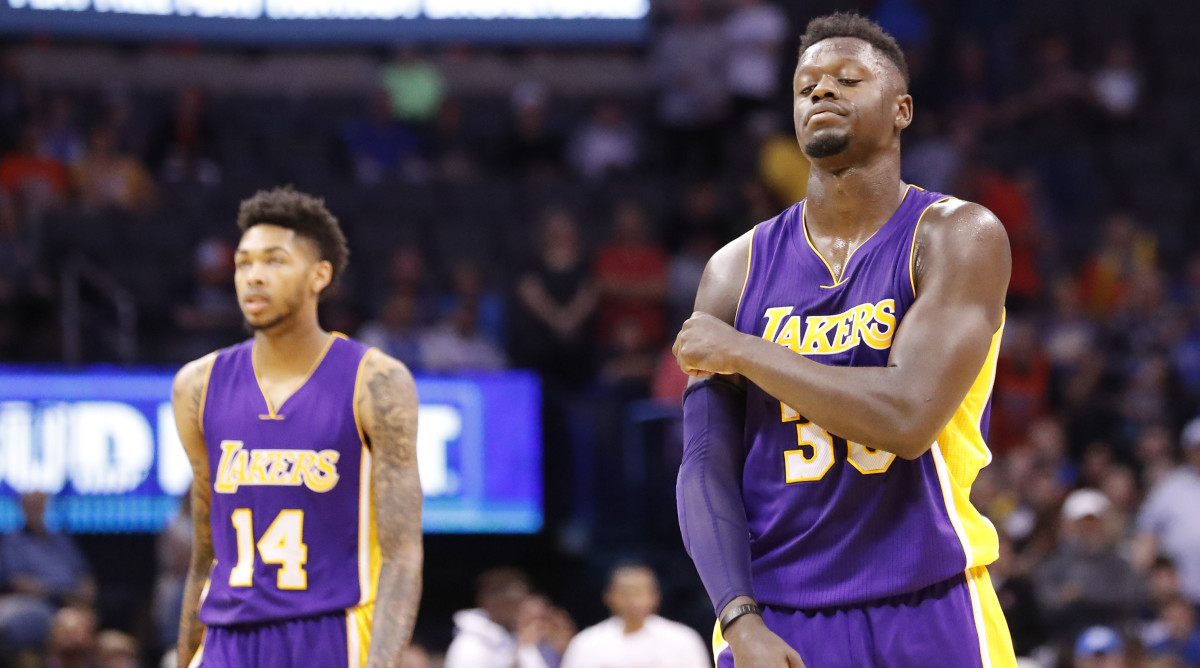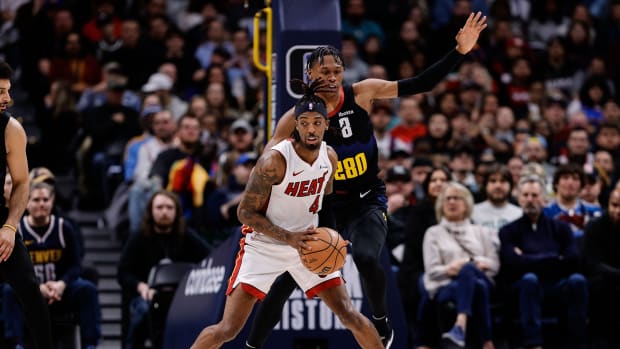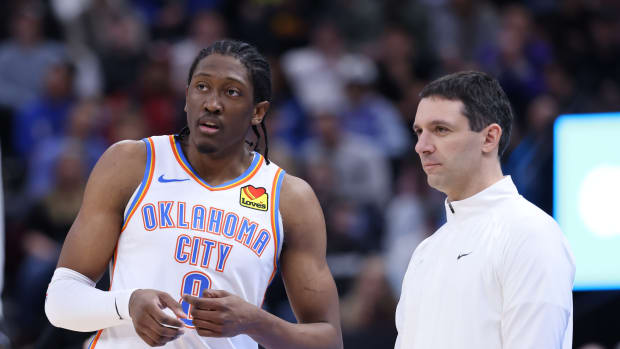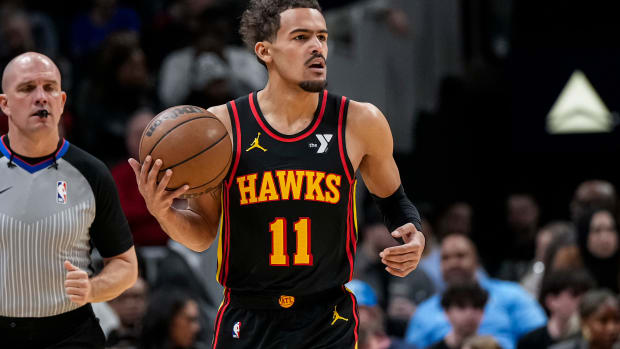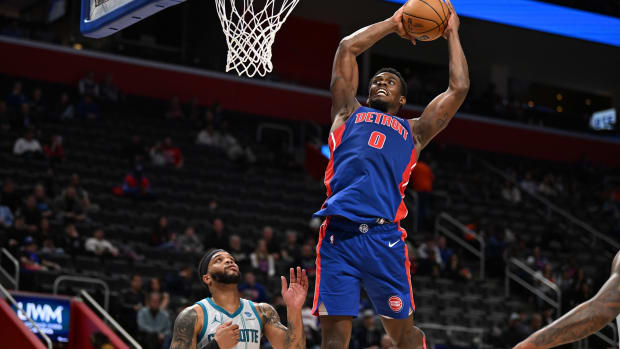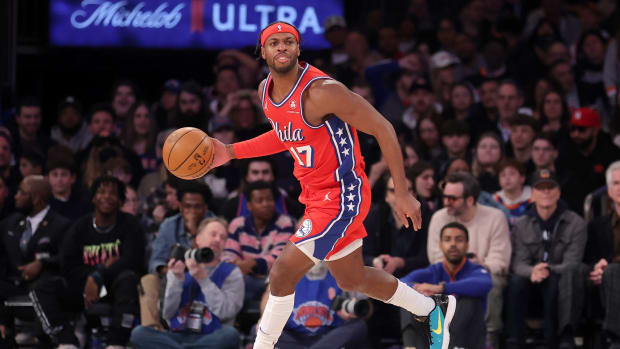Should We Feel Good About The Lakers' Rebuild?
Sixty-four days ago in Chicago, Julius Randle saw a matchup he liked. With 49 seconds left in a tie game, the Lakers' 22-year-old screamed for the ball. Once he got it on the left wing, Randle took two strong dribbles to his right before spinning left and banking home the game winner. It was exactly what you wanted to see from a young star and a developing team: a clutch play, a close win, and a sign that better days were ahead.
The youthful Lakers were 10-10 after the victory over the Bulls. Luke Walton had his team playing hard, the offense was clicking, and the eclectic roster seemed to kind of, sort of have a chance at the No. 8 seed. After enduring a team-record 65 losses last year during Kobe Bryant's awkward swan song, the Lakers were finally fun again.
Alas, Los Angeles would follow that win with eight straight losses and dropped 15 of its next 17. Since that night, the Lakers are now 7-24, and only the Nets have more losses than L.A.'s 34. The low point came on Jan. 22, when the sub-.500 Mavericks beat the Lakers by 49, the worst loss in franchise history. Wide-ranging conclusions shouldn't be drawn off one game—no matter how terrible—but that annihilation provided a sobering reminder of just how far the Lakers have to go.
Through 20 games, the rebuild appeared to be ahead of schedule, with a young core appearing capable of navigating the franchise through the post-Kobe era. But the slide since has prompted questions as to whether that nucleus (Randle, D’Angelo Russell and Brandon Ingram—and Jordan Clarkson? Ivica Zubac?) can lead this proud franchise back to prominence.
Reasons for pessimism
During the encouraging start, the Lakers masked their defensive deficiencies with a fast, motion-oriented attack. It’s clear Walton brought some of the Warriors' principles down the coast with him. The Lakers were taking advantage of their speed and athleticism by pushing the tempo whenever possible.
They've slowed down their pace significantly since. The Lakers don't have the consistent playmaker necessary to anchor a slower-paced attack, and the offense has stalled considerably. For a team that hasn't been able to stop anybody all year, this regression has been crippling.
Lakers In 2016-17
Create your own infographics
(Stats above through Jan. 30).
There have been injuries—Russell, Young and Nance have all missed significant time—but no single factor explains the Lakers' offensive regression. They're suffering from a lack of identity. They don't shoot a lot of threes (25.8 per game, 18th-most). They run a ton of pick-and-roll (fourth-most), but aren't particularly good at it (.82 points per possession, 19th-best). They don't play particularly quick anymore, and they're not sharing (27th in assist percentage) nor taking care of the basketball (25th in turnover percentage). The offense has become a nondescript unit that too often relies on Lou Williams to create something out of nothing.
Now that the offense has slowed, L.A’s glaring, malignant defensive issues are catastrophic. They are league-worst or close to it in nearly every defensive stat.
Part of this is attributable to youth—it takes young players a while to learn the intricacies of NBA defense, which is generally more complicated than college schemes. Here, the Lakers make two fatal mistakes: Ingram flails hopelessly at a pump-fake, and Russell forgets entirely about his man in the corner.
These are mental blunders that should decrease as the young guys mature, and remember that Walton is also in his first year. He, too, is still learning.
Yet you’d expect a young team with defensive potential and a first-year head coach to improve defensively as the year wears on. The opposite has occurred. The Lakers have gotten worse each month in key defensive categories like points allowed and opponent FG%. Perhaps the problem is with the personnel, not the scheme.
Randle's effort levels are pretty good, but he's not a terrific leaper, and his short arms limit his defensive ability. His height and lack of length don’t offer much rim protection. Russell tends to fall asleep on the defensive end of the floor. His limited lateral quickness makes it hard for him to stay in front of his man, particularly when guarding one of the league's springier guards. And Ingram is vulnerable to a good old-fashioned post up because he's still so damn skinny, though he has the most defensive potential of the three. The team's best defenders—Tarik Black, Nance, Luol Deng and Williams—are not the players the Lakers want to build around.
Offensively, L.A's best player this season—the only Laker with a positive plus/minus rating—is Williams. He's 30 and not part of the team's young nucleus. Russell, who the Lakers are banking on as the point guard of their future, is in just one of the Lakers' six best lineups (min. 20 games).
Most concerning has been a lack of consistent effort and focus. Early in the year, L.A.brought a jovial energy to every game. Now that effort is of the sometimes-there, sometimes-not-there variety. That's led to the Lakers' losing the early-season buzz to other young, more successful teams—like the Sixers and Bucks. After a start that appeared to be proof of significant progress, L.A. is now more likely to keep its top-three protected pick than to sniff the playoffs. As of right now, Randle, Russell and Ingram project as solid NBA players, but no one has emerged yet into the type of surefire future All-Star you could build around (think Embiid or Giannis).
Reasons for optimism
Let's take a deep breath. The Lakers are still young. Really, really young. Randle is 22, Russell is 20, Ingram is 19, and, lest we forget, Walton is 36. Those three players are also in their first true season of player development—last year was a complete wash in that department, as Byron Scott permitted Kobe Bryant to hijack the offense. These guys are in the first half of the first chapter of their NBA careers, and each does really encouraging things, particularly on offense.
Randle’s playmaking abilities are much improved this season, as he’s tied for fourth in assists among power forwards. He has a tight handle for his size and he's an absolute load when he drives angrily toward the hoop. He’s really hard to guard when he runs the coast-to-coast break, something he likes to do:
Of the young players, Randle is the closest to his ceiling. That's partly because he's playing the best (13.0 points, 8.4 rebounds, 3.8 assists and 49% FG), but also because it's difficult to identify areas where he can greatly improve. Randle probably won't be a star, but he should be a double-double machine for years to come.
Russell has shown flashes of being able to facilitate an NBA offense, like in last night's win over Denver, when he finished three rebounds shy of a triple-double and turned it over just twice. Despite his modest assist numbers (4.6 per game), he's a very instinctive and talented passer. He's statistically below average as a ball handler in pick-and-rolls—35.2 EFG% and a turnover rate of nearly 20%—but he shows signs of elite pick-and-roll play. Again, he's 20, and he's going to get more effective with more reps. The tools are there.
Russell's jump-shooting struggles are concerning, though. He's hitting on just 30.8% of jumpers this season and making just 34.3% of his three's on nearly six attempts per game. That needs to improve.
Russell's flaws are not insignificant, but his numbers stack up quite well to other point guards at his age: this season, he has sixth-best PER, fourth-highest points/36 minutes, and fourth-best assist and rebound percentage of any season by a 20-year-old point guard in NBA history. Russell has stretches where he looks like the league's next great point guard, but his shot selection and decision-making betray his inexperience. If he matures in his approach both on and off the court—and, crucially, if his shooting improves—he has the savvy, handle and passing ability to be an All-Star in his prime.
The beginning of Ingram's NBA career was historically dreadful, but he's showing signs of life. He is breathtakingly thin but also Durant-level long, and he's comfortable facilitating offense from a point-forward role. At times he looks like the versatile scorer the Lakers need him to become—he’s immensely talented and you cannot teach this length.
The takeaway: Ingram is the second-youngest player in the league. He’s going to be just fine.
Another recent development has been the emergence of Zubac, a 19-year-old, seven-footer the Lakers took in the secound round out of Bosnia and Herzegovina. Over his last three games, Zubac is averaging 15 points, 8.7 rebounds and 1.0 block in just 25 minutes. He's certainly worth keeping an eye on as another potential building block and pick-and-roll partner for Russell.
Looking ahead
Randle, Russell and Ingram are too young, and the tape is too promising to lose hope. Walton and his team are growing together, and growing is nearly always accompanied by growing pains. Consider the Sixers, who started 7-24 and appeared to be doomed to another year of bottom-dwelling. Then they turned a corner and won 8 of 11, and all of a sudden we’re Trusting the Process.
Philly is evidence that these rebuilding projects take time. They ebb-and-flow, there are highs and lows, and teams often turn the corner when we least expect them to. The Lakers may not be next in line for a Sixers-like turnaround—they’re miserable defensively and don’t have a clear franchise player. But they very well could be—they have three really promising young players and a coach who is still finding his voice, a lot of their defensive issues are mental and they've shown they can be an above-average offense. Only time will tell whether their shortcomings are a product of youth and inexperience, or if they’re structural and insurmountable.
The pieces are in place. Whether they're the right pieces remains to be seen.






























